Range Hood Specifications Explained: Width, Mounting Height, CFM and Style Options
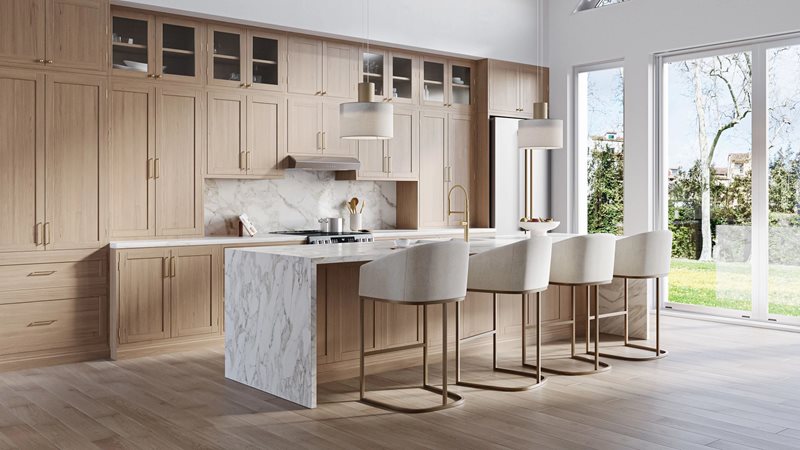
If you are remodeling your kitchen or building a new home, installing a range hood is essential. You may already have a hood or an over the range microwave, but it is important to make sure your current setup is actually doing its job. Your hood should remove pollutants and excess moisture, protect your cabinets, and maintain healthy indoor air. It also needs to be the right size and have enough power to perform effectively.
Too much moisture can warp cabinets and peel wallpaper. Cooking releases volatile organic compounds and fine particles that can irritate allergies and asthma. A well selected range hood removes these pollutants at the source which makes range hood selection one of the most important ventilation decisions in your home.
Learn more about why ventilation matters here, “Range Hoods and IAQ: Why Ventilation Is Essential for a Healthier Kitchen”
Width
Matching the width of your range hood to the width of your cooktop is essential for proper capture. When the hood is too narrow, fumes and moisture escape into the kitchen which leads to unpleasant odors, grease buildup, cabinet damage and lower air quality.Width for Custom Cabinets
If you have a custom cabinet above your range, choose a built in hood (power pack or insert) that matches the width of your cooktop. Measure your cabinet carefully to ensure the hood fits correctly. In some situations you may need a slightly narrower hood to fit inside the enclosure.
Mounting height
The height at which you mount your range hood is critical. Installation requirements vary based on:
- Fuel type (gas or electric)
- Hood style (under cabinet, chimney, island, built in, downdraft)
- Range width
CFM: Understanding Hood Power
A range hood’s power is measured in CFM which stands for cubic feet per minute. Selecting the correct CFM ensures your hood can exhaust smoke, steam, and cooking fumes properly.A general rule is: 100 CFM for every 10,000 BTUs of your range.
For example, a 40,000 BTU gas range should be paired with a hood that moves around 400 CFM. If your hood exceeds 400 CFM, many building codes require make up air to replace the exhausted air.
Learn more about airflow and CFM measurement here, “Range Hood CFM Guide: How to Choose the Right Power for Your Kitchen”
Cooking Level and Range Type
Your cooking style influences the level of ventilation you need. Searing, frying, wok cooking, and high heat techniques release higher levels of smoke and grease. Conventional electric ranges usually pair well with standard hoods, while high performance and pro style gas ranges require stronger CFM for effective capture.
Range Hood Styles
Now that you have considered your kitchen layout and ventilation requirements, you can select the style that best fits your design and performance needs.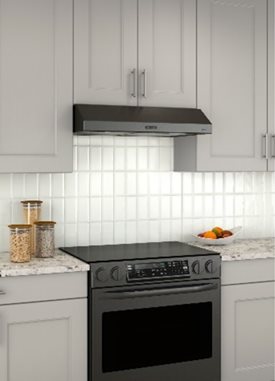 Undercabinet
UndercabinetUndercabinet range hoods are popular because they provide excellent ventilation while preserving precious cabinet space. An undercabinet hood is likely the right product if you plan to keep existing over-the-range cabinetry. Installation of these hoods is simple enough for most DIYers via our EZ-1 Install System, making swapping out an old, outdated model fast and easy. Due to cabinetry design and trim detail, you may need a professional to install your new range hood for more complex kitchen setups.
Chimney
 Chimney range hoods are a stylish focal point for your kitchen. Install a chimney hood approximately 24" – 28" above your cooktop. This is a generality, and you should consult the installation instructions for your hood. These range hoods are quite popular because they can transform the look of your kitchen. The most popular style of hood is the classic pyramidal shape. Other styles include rounded glass, box, or a sleek T-shape that could pair well with linear Modem décor, among many others.
Chimney range hoods are a stylish focal point for your kitchen. Install a chimney hood approximately 24" – 28" above your cooktop. This is a generality, and you should consult the installation instructions for your hood. These range hoods are quite popular because they can transform the look of your kitchen. The most popular style of hood is the classic pyramidal shape. Other styles include rounded glass, box, or a sleek T-shape that could pair well with linear Modem décor, among many others.Island
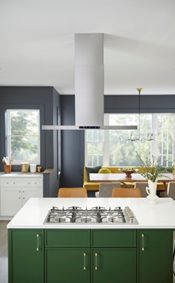 Island range hoods offer many of the same great styles as chimney hoods but are designed for use over an island or peninsula. These range hoods provide the performance level needed in the open concept of an island-based range. Island range hoods are finished on all four sides to give elegance and beauty no matter where you stand in your kitchen.
Island range hoods offer many of the same great styles as chimney hoods but are designed for use over an island or peninsula. These range hoods provide the performance level needed in the open concept of an island-based range. Island range hoods are finished on all four sides to give elegance and beauty no matter where you stand in your kitchen. Built-in range hoods
Built-in range hoods, also called power pack or insert, range hood styles can satisfy various design aesthetics. Built-in range hoods are designed to fit inside a custom cabinet or enclosure. The design possibilities are endless with a built-in range hood.
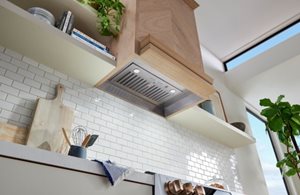
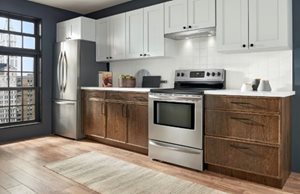
Downdraft
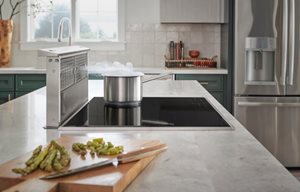 Downdraft range hoods install behind your range or cooktop and come in sizes that match most. The type of range or cooktop that pairs with a downdraft will not have a vertical backing; the controls will be near the face on the side(s) or the front of the range or cooktop. The downdraft fits behind the range or cooktop within your cabinetry and exhausts out of the home in almost all directions except upwards. The downdraft is often installed in an island but can be installed in any counter, assuming there is room for it. A downdraft works by rising out of the counter and pulling air down into the hood. When raised, the height of the downdraft is between 9" – 18", depending on the model you choose. During use, the overall height is low enough to maintain the openness of your kitchen area and sight line to the surrounding areas. The uniqueness of this range hood is its efficient and effective ventilation and the way it can be "stored away" flush with your countertop when not in use.
Downdraft range hoods install behind your range or cooktop and come in sizes that match most. The type of range or cooktop that pairs with a downdraft will not have a vertical backing; the controls will be near the face on the side(s) or the front of the range or cooktop. The downdraft fits behind the range or cooktop within your cabinetry and exhausts out of the home in almost all directions except upwards. The downdraft is often installed in an island but can be installed in any counter, assuming there is room for it. A downdraft works by rising out of the counter and pulling air down into the hood. When raised, the height of the downdraft is between 9" – 18", depending on the model you choose. During use, the overall height is low enough to maintain the openness of your kitchen area and sight line to the surrounding areas. The uniqueness of this range hood is its efficient and effective ventilation and the way it can be "stored away" flush with your countertop when not in use. Professional
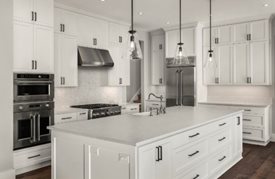 Professional range hoods are similar to the type used in professional kitchens. They are often quite large and work with large or high-powered gas ranges. Of all the indoor range hood types, the pro canopy range hood has the highest CFM capacity to properly and efficiently ventilate large ranges. This may be the look and performance you need to keep your kitchen well-ventilated if you are a gourmet cook.
Professional range hoods are similar to the type used in professional kitchens. They are often quite large and work with large or high-powered gas ranges. Of all the indoor range hood types, the pro canopy range hood has the highest CFM capacity to properly and efficiently ventilate large ranges. This may be the look and performance you need to keep your kitchen well-ventilated if you are a gourmet cook. Outdoor
Outdoor range hoods provide ventilation to outdoor entertainment areas, generally over a grill. Even though you are outdoors, heat and other emissions get trapped under the roof. The outdoor hoods come in an undercabinet, chimney, island, or built-in style with high-performance ventilation based on the environment in your outdoor area. These hoods are extra-deep and wide for capture efficiency to cover a grill's surface area. They are made from special corrosion-resistant stainless steel to provide long-lasting beauty from the extreme grill temperatures and outdoor elements it will experience. No matter the setup of your outdoor entertainment area – there is a range hood to capture and provide the look and design you want.
Selecting the right range hood style is a key step in creating a kitchen that is both beautiful and functional. Now that you understand your ventilation needs, space constraints, and cooking habits, you can choose the hood that best fits your home. Narrowing the field down from here to a hood with the best performance is your next step, and you can learn about that here, "Key Considerations When Choosing a Range Hood for Your Kitchen".

 English
English
 English
English